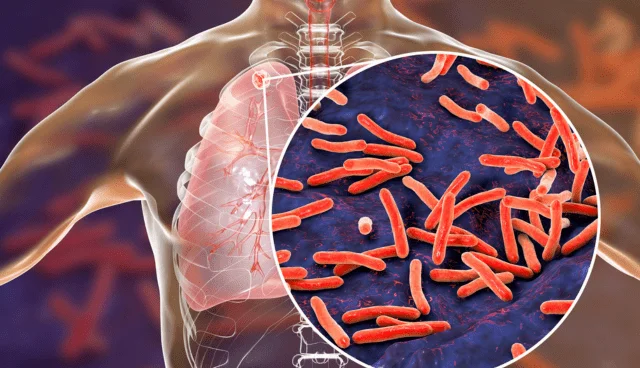
What is Tuberculosis?
The dangerous illness known as tuberculosis, or TB, has afflicted people for generations. It is a bacterial infection caused by Mycobacterium tuberculosis, affecting primarily the lungs but potentially impacting other parts of the body as well. In this comprehensive blog post, we will delve into what tuberculosis is, explore the causes of TB disease, and discuss its symptoms.
Understanding Tuberculosis
Tuberculosis, or TB, is a bacterial infection caused by Mycobacterium tuberculosis. It is a serious and potentially deadly disease that primarily affects the lungs but can also affect other parts of the body. TB is one of the oldest known infectious diseases, with evidence of its presence dating back thousands of years.
TB Transmission
TB is an airborne disease, meaning it spreads through the air when an infected person coughs, sneezes, or talks. The bacteria-containing droplets can be inhaled by individuals nearby, leading to the transmission of the disease. While TB primarily affects the lungs, it can also affect other organs, such as the kidneys, spine, and brain, through the bloodstream.
Latent TB vs. Active TB
Not everyone who is exposed to Mycobacterium tuberculosis becomes ill. Some individuals may develop latent TB, where the bacteria remain dormant in their bodies and do not cause any symptoms. However, in some cases, latent TB can progress to active TB disease, leading to symptoms and potential transmission to others.
What Causes Tuberculosis?
Understanding what causes tuberculosis involves looking at the bacteria responsible for the disease, its transmission, and risk factors associated with its development.
Mycobacterium tuberculosis
Mycobacterium tuberculosis is the main cause of TB. This bacterium is unique in several ways that contribute to the disease’s persistence and challenges in treatment. It has a thick, waxy cell wall that makes it resistant to many antibiotics and allows it to survive for extended periods in the environment.
Transmission
As mentioned earlier, TB spreads through the air when an infected individual coughs, sneezes, or talks. It is crucial to note that close and prolonged contact with an infected person increases the risk of transmission. Living in crowded and poorly ventilated environments also elevates the chances of contracting TB.
Risk Factors
Several risk factors can increase an individual’s susceptibility to tuberculosis. These include:
- Weakened Immune System: People with weakened immune systems, such as those with HIV/AIDS or on immunosuppressive medications, are more vulnerable to TB.
- Malnutrition: Poor nutrition can weaken the immune system, making it harder for the body to fight off the TB bacteria.
- Close Contact: Living or working in close quarters with someone who has active TB disease increases the risk of transmission.
- Substance Abuse: Drug and alcohol abuse can weaken the immune system, making individuals more susceptible to TB infection.
- Age: Infants and the elderly are more susceptible to TB infection due to weaker immune responses.
What Are the Symptoms of TB Disease?
Identifying the symptoms of TB disease is crucial for early diagnosis and treatment. TB can manifest differently depending on whether it affects the lungs (pulmonary TB) or other parts of the body (extrapulmonary TB).
Symptoms of Pulmonary TB
Pulmonary TB primarily affects the lungs, and its symptoms may include:
- Persistent Cough: A cough that lasts for several weeks, producing phlegm or blood.
- Chest Pain: Pain or discomfort in the chest, often aggravated by coughing or breathing.
- Coughing up Blood: Hemoptysis, or coughing up blood-tinged sputum, is a concerning symptom of TB.
- Fatigue: Unexplained and persistent fatigue or weakness.
- Fever: Low-grade fever, often occurring in the afternoon or evening.
- Night Sweats: Profuse sweating, especially during the night.
- Loss of Appetite: A significant reduction in appetite leading to weight loss.
- Swollen Lymph Nodes: lymph nodes that are enlarged, commonly in the neck.
Symptoms of Extrapulmonary TB
Extrapulmonary TB can affect various organs and may present with symptoms specific to the affected area. Some common forms of extrapulmonary TB include:
- Tuberculous Meningitis: Headaches, neck pain, and altered mental state.
- Skeletal TB: Bone pain and joint swelling.
- Genitourinary TB: Painful urination, blood in urine, or lower abdominal pain.
- Abdominal TB: Abdominal pain, diarrhea, and weight loss.
- TB in Lymph Nodes: Swollen and painless lumps in the neck, armpits, or groin.

Conclusion:
In conclusion, tuberculosis, often referred to as TB, is a serious bacterial infection caused by Mycobacterium tuberculosis. It is primarily transmitted through the air when an infected individual coughs or sneezes, making close contact a significant risk factor for contracting the disease. TB can affect the lungs (pulmonary TB) or other parts of the body (extrapulmonary TB) and presents with a range of symptoms, including persistent cough, chest pain, and fatigue.
Early diagnosis and treatment are essential to prevent the spread of TB and improve outcomes for affected individuals. If you or someone you know is experiencing symptoms of TB disease, it is crucial to seek medical attention promptly. TB is a curable disease with the right antibiotics and proper medical care, so timely intervention is key to preventing its progression and complications.
While significant progress has been made in the fight against tuberculosis, it remains a global health concern, particularly in regions with high prevalence rates. Public health efforts, including vaccination, early detection, and treatment, continue to be vital in reducing the burden of this disease and working towards its eventual eradication. Understanding what tuberculosis is, its causes, and its symptoms is the first step in this ongoing battle against TB sickness.
